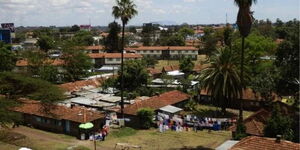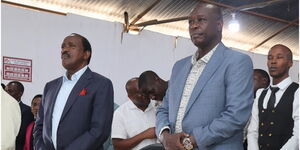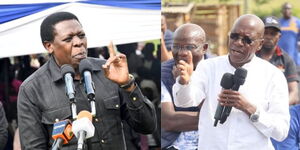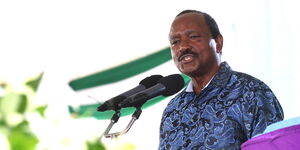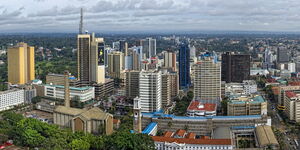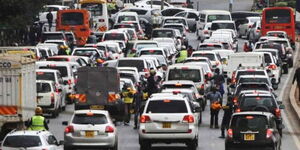President William Ruto delivered one of the longest Madaraka Day speeches in recent times on Sunday, May 1. His speech addressed a range of issues and contained several updates directly affecting Kenyans.
Below is the President's full speech:
Your Excellency Nataša Pirc Musar, President of the Republic of Slovenia, Ladies and Gentlemen,
It gives me immense joy to be back in the county of endless potential.
It has been 62 eventful years since we took this historic step towards full independence, and through hard work, determination and self-belief, we have defied odds, surmounted challenges, triumphed over adversity, and emerged as a modern democratic state whose government and economy are energised by the restless ambition of confident citizens.
Our forefathers knew, as we do, that we, the people, are the foundation, pillars, and engine of this nation, and that only we can do the work of building the Kenya we want. More critically, we understand keenly that this country is our home and we have no other. This is why wherever they go all over the world, Kenyans never forget their homeland, and vigorously contribute to nation-building.
We are acutely aware that although we have given a decent account of ourselves since the first Madaraka Day, we are quite far from where we ought to have reached. It is time for us to reflect on the state of our collective self-belief as a people because, without it, we lose all the opportunities that come with Madaraka.
We all know that Kenya is not short of imaginative strategies and bold visions. In fact, so good are some of our plans that other countries have successfully implemented them and achieved impressive progress.
Our biggest problem has always been one of implementation and execution: the faith to believe in our plans for change; the courage to execute, and the patience and focus to get it done. Some do not believe that we deserve the good that comes with positive change, others think we are too poor or even in the wrong part of the world. Yet still, others do not want to see changes that benefit ordinary people or make life better for everyone.
Today I want to persuade the doubters that no one else is going to bring change except us, and that the only way to build the Kenya we want is by embracing change, however uncomfortable it may seem at first, and that we must possess the self-belief, individually and collectively, to approach our tasks boldly, confidently, and with determination in order to deliver new, more and better, sooner rather than later.
Ladies and gentlemen, over two and a half years ago, we embarked on an ambitious journey of national renewal powered by the Bottom-Up Economic Transformation Agenda (BETA) and rooted in the will and sovereign consent of the people of Kenya. Bottom-Up is not just a mere slogan. Today, it is a lived reality for millions of Kenyans, transforming lives and reshaping destinies across the country, day by day. This agenda is the expression of a deeper yearning among Kenyans to take control of their own fate and break free from a long history of hopelessness, dependence, and exclusion.
This renewal of our commitment to deliver on the fundamental mandate of Madaraka is inspired by the enduring spirit of self-determination through which we vowed to give ourselves not only what was denied to us during colonialism, but also what every citizen and every human being deserves: liberty, dignity, security, and opportunity.
Madaraka affirms our collective faith, shared across generations of Kenyan patriots, that through hard work, innovation, and resilience, our farmers, traders, youth, workers, and professionals will rise to the occasion. With the strength of our imagination and effort, we can, and must, transform this nation with the imagination of our own minds and the work of our own hands.
I speak to you today with the deep conviction that our country is firmly on the path to stability and progress. We have weathered turbulent times, navigated serious challenges, and through courageous policy decisions pursued with resolve, we have not only stabilised our economy but also charted a clear course to long-term prosperity.
Since August 2022, Kenya has recorded an average annual growth rate of 5%, outperforming the global average of 3.3% and the regional average of 3.8%. Just last month, the International Monetary Fund projected our GDP to reach $132 billion (KSh17 trillion), making us the largest economy in our region and the sixth-largest in Africa. At the same time, inflation has declined sharply from 9.6% in October 2022 to 3.8% in May this year, well below our 5% target, and bringing welcome relief to households and businesses. This reflects the strength of our economic fundamentals and the impact of our bold reforms.
During the same period, the shilling appreciated by nearly 20% against the US dollar, from KSh 162 to KSh 129, making it one of the best-performing currencies in the world. The Central Bank Rate has decreased from 13% to 10%, lowering the cost of borrowing and spurring private sector activity. Additionally, our foreign exchange reserves now stand at $10 billion, extending our import cover from 2.5 to 4 months.
Ladies and gentlemen, the Affordable Housing Programme stands as a powerful symbol of the socio-economic transformation underway across Kenya. Just last week, I had the privilege of handing over keys to the first 1,080 social housing units in the new Mukuru Estate, Nairobi.
As I said then, while it was a life-changing moment for the new homeowners, it was equally one of the most profound and consequential days in my political career to witness how a deliberate government policy can uplift lives, restore dignity, and offer hope to communities that have long lived on the margins of our society: vulnerable, forgotten, and neglected. It also marked a proud milestone for Kenya and demonstrated that ambitious national programmes can be successfully implemented to deliver tangible benefits to ordinary citizens and fundamentally reshape our understanding of meaningful change.
To see families move from the hardship of overcrowded slums to the relative comfort of permanent homes, complete with electricity, running water, and clean cooking gas, was a powerful reminder of what pro-people policies can deliver, and the great things we can achieve together when we focus our thoughts and energy on possibilities and action, rather than obstacles and doubt.
A little over two years ago, many were sceptical when we said that ordinary Kenyans could begin owning homes through a rent-to-own model using the same amount they paid in rent. Today, that bold promise is being fulfilled. We saw the joy of Jerusha Muthoni, a mother of three, grandmother of four, and second-hand clothes trader from Mukuru kwa Reuben, as she stepped into her new home.
Here in Homa Bay County, the county of limitless opportunities, just two days ago, I had the pleasure of handing over keys to the first occupants of 110 affordable housing units at the Boma Yangu Housing Estate. Among the proud new homeowners, some of whom are with us today, were Kennedy Otieno Odede, a boda boda rider; Hellen Atieno Osala, a mama samaki at the New Modern Fish Market; Geoffrey Odhiambo Nyasuda, a jua kali fabricator; and Vincent Ochieng’ Onyango, a security guard.
The journeys of new homeowners like Jerusha Muthoni in Mukuru, Kennedy Odede in Homa Bay, and thousands of others across the country, from the dehumanising squalor of informal settlements to the security and pride of a permanent home, stand as powerful testaments to the transformative promise of bottom-up empowerment. They prove that with vision and resolve, courage and conviction, we can lift even the most forgotten among us into lives of dignity, hope, and limitless possibility.
Ladies and Gentlemen, if you didn’t understand what we meant by ‘bottom-up’, now you do. If you didn’t believe, now you believe. And if you thought it was a fantasy, as contributors to the housing levy, you are now witnessing and making history, history that will be remembered for generations to come in the story of Kenya.
We are firmly on course to delivering 150,000 housing units under the Affordable Housing Programme, which have been under construction since September 2022, with 11,000 units already completed. Very soon, I shall be handing over keys to new homeowners in Bahati and Elburgon in Nakuru County, Mabera in Kuria West, Emgwen in Nandi, Milimani in Kakamega and Vihiga counties, Nanyuki, and many other parts of the country. The Bottom-Up Transformation is reaching every corner of Kenya, leaving no one behind.
Beyond providing dignified shelter, this transformative programme is driving job creation, having already generated over 250,000 jobs. It is nothing short of a nation-building revolution — uplifting lives, growing businesses, and redefining the future of work and urban living in Kenya. 20. Fellow Kenyans, in recognition and appreciation of the sacrifice made by patriotic Kenyans through their contributions to the Housing Levy, I am pleased to announce today that we shall be proposing to Parliament a reform to the law that will allow any contributor to access an affordable home loan of up to KSh5 million at a single-digit interest rate, applicable toward any housing unit in the market. This facility will also enable contributors to offset existing mortgages, offering greater flexibility in their housing journey and allowing many to significantly ease their home financing costs. These reforms will ensure that every shilling contributed to the Housing Levy works for the contributor, whether through access to affordable housing, home loans, or mortgage relief.
Ladies and Gentlemen, word is beginning to get out throughout the nation that “SHA is working”, by which citizens mean that the transition challenges and teething problems are now behind us, and Universal Healthcare Coverage is now serving Kenyans and leaving nobody behind. Since the rollout of Taifa Care in October 2024, 23 million Kenyans have so far registered with the Social Health Authority (SHA), a resounding vote of confidence in our reformed healthcare model. We are now recording an average of 50,000 new registrations daily, a clear testament to the fact that Kenyans have embraced a system designed to guarantee access to quality, affordable, and dignified healthcare for all.
In just eight months, SHA has disbursed KSh43 billion in claims to facilities, with 4.5 million Kenyans having received treatment fully covered by SHA since its inception. For the first time in Kenya’s history, under SHA, citizens can access free emergency services in all facilities, funded by the government through the Emergency, Critical, and Chronic Illness Fund. This groundbreaking reform is eliminating the burden of mandatory deposits demanded by hospitals.
To sustain this momentum, the government has allocated sufficient resources to fully fund primary healthcare services. Every registered Kenyan can now access care in public and SHA-contracted facilities at no cost. Taifa Care is universal in both word and deed. This healthcare service delivery transformation goes beyond the magnitude of numbers of new beneficiaries to real impact. SHA is settling payments promptly, ensuring that no Kenyan is turned away due to a lack of funds.
Additionally, to expand access to comprehensive inpatient care, the Social Health Authority (SHA) is prioritising the enrolment of all Kenyans, with a particular focus on those in the informal sector, many of whom were previously excluded under the now-defunct National Health Insurance Fund (NHIF). Although informal households account for approximately 80% of the population, they have historically faced significant barriers to accessing health insurance. So far, 1.7 million informal sector households have successfully enrolled and paid for social health insurance, a record achievement representing the highest number of informal sector enrolments in a single year in the history of Kenya.
To address persistent challenges such as irregular premium contributions among informal sector workers, we are introducing an innovative and inclusive payment solution called LIPA SHA POLE POLE. This initiative enables Kenyans to remit their annual SHA contributions through flexible, manageable instalments, whether monthly, weekly, or even daily, based on their financial ability. It ensures families maintain continuous health coverage without financial strain, while simultaneously promoting the sustainability of the health insurance fund. LIPA SHA POLE POLE has been made possible through a strategic partnership between the Ministry of Health, the Ministry of Cooperatives and MSMEs, Mobile Network Operators, and Financial Institutions, through the Hustler Fund. The system is simple and accessible; citizens can dial *147# and follow the prompts to enrol and begin their contributions immediately.
In addition to enhancing access to health insurance, we have prioritised the availability of essential medical equipment in public health facilities. Moving away from the previous Managed Equipment Services (MES) model, which placed maintenance and service delivery responsibilities solely on county governments, we have adopted a more efficient approach under the National Equipment Supply Programme. Under this new model, the national government, working in collaboration with county governments, engages directly with equipment manufacturers and suppliers to deploy critical medical equipment based on county-specific needs. Payments are made on a fee-for-service basis, aligned with the gazetted SHA tariffs. This output-based financing mechanism ensures that facilities are reimbursed only for actual services rendered, thereby enhancing accountability and guaranteeing the availability, functionality, and quality of medical services across public health institutions.
I urge every Kenyan to take charge of their health by enrolling with the Social Health Authority (SHA), so that together we can end the heartbreaking cycle where families are forced to auction their livestock, sell their land, or part with their life’s possessions just to afford medical care.
No Kenyan should have to choose between life-saving treatment and their dignity. Let us unite to build a healthcare system rooted in dignity, equality, and compassion; a system where access to care is a right, not a privilege for a few.
You will agree with me, fellow Kenyans, that the remarkable progress we are making in both affordable housing and Taifa Care has been made possible by the solidarity, trust, and commitment with which Kenyans have participated in and contributed to the realisation of radical, positive change on an unprecedented scale. The evidence before us, of real progress with real impact on people’s lives, should encourage and inspire us to do even more, together, with greater confidence, and to turn Kenya into the country we all aspire to build.
I extend my deepest gratitude to the millions whose housing levy contributions are restoring dignity to fellow citizens who may never have dreamt of owning a decent home. I also thank all who support SHA and are helping turn our vision of Universal Healthcare Coverage into a lived reality for millions across our country.
Ladies and gentlemen, through strategic investments in agriculture, we are accelerating both growth and resilience in the sector. Fertiliser subsidies have boosted food production by 50%, while reforms in the coffee and sugar sectors have revived local industries, enhanced farmer incomes, created jobs, and reinvigorated rural economies. Today, milk farmers are earning KSh50 per litre, up from KSh35. Coffee farmers are now earning up to KSh150 per kilo, a remarkable increase from an average of KSh65. Tea earnings rose from KSh138 billion in 2022 to KSh215 billion in 2024. Sugar production surged from 490,000 metric tonnes in 2023 to 815,000 metric tonnes in 2024, enabling us to reduce sugar imports by 70%, while increasing farmers’ earnings from KSh50 billion to KSh90 billion.
We have intervened with consistency and focus to ensure sugarcane growers receive fair returns for their deliveries and that they get paid in full and on time. To anchor these gains sustainably, we must recognise that increasing the efficiency of milling plants is central to farmers’ interests. Efficient mills are more profitable and offer farmers optimal returns. Conversely, outdated mills, some of which run on plants that are over 50 years old, recover only one tonne of sugar from nearly 20 tonnes of cane, shortchanging our growers and robbing them of their sweat.
In this connection, the recent competitive leasing of four state-owned factories—Nzoia, Chemelil, Sony, and Muhoroni—is another strategic step to inject efficiency, restore profitability, and safeguard farmers’ livelihoods. Our goal is to modernise the mills, ensure prompt payment to farmers, workers’ salaries and wages, and transform these once-struggling factories into productive and sustainable enterprises.
For years, these factories were a financial burden on the Exchequer, surviving only on repeated taxpayer-funded bailouts while failing to pay farmers and workers. The government has acknowledged its limitations in managing these mills. Let it be clearly understood that neither the factories nor their assets, including land, have been sold. They remain public property, leased under strict terms to private sector players to deliver shared value and revive the industry for the benefit of farmers, workers, communities, the sector and the nation.
As we dedicate our efforts to nation-building, we are also preparing Kenya to thrive in an increasingly competitive, complex future. This requires equipping our learners with the knowledge, skills, and mindset necessary to seize opportunities and contribute meaningfully to national development.
Guided by bold recommendations from the Presidential Working Party on Education Reform, we are undertaking the most transformational shift of our education system in over six decades.
We have successfully transitioned to a Competency-Based Education system, moving away from rote learning towards a dynamic, skills-based approach aligned with 21st-century needs and our socio-economic goals. Our next priority is to ensure every school has the infrastructure and equipment needed to support both learners and teachers.
To support this transition and respond to the needs of our growing population, we have undertaken the largest teacher recruitment drive since independence, employing 76,000 new teachers over a period of two years, and are on course to employ an additional 24,000 by January 2026. We have also built more than 23,000 additional classrooms, easing pressure on existing infrastructure and shielding teachers and learners from the burden of overcrowded classrooms.
At the tertiary level, we have revolutionised education financing through a new student-centred funding model that ensures the sustainability of our TVETS and universities, while expanding access for learners. Today, students from poor families get up to 90% of government scholarships, with parents paying only a nominal fee. In recognition of the transformative power of technical and vocational education and training (TVET) in tackling pressing socio-economic challenges such as youth unemployment, skills gaps, and poverty, the government is aggressively scaling up investment in technical training. TVET college enrolment is set to grow fourfold, from 500,000 in 2023 to 2 million by the end of this year, equipping a new generation with the skills and knowledge needed to drive Kenya’s industrialisation, innovation, and economic competitiveness.
Ladies and gentlemen, to further empower ordinary Kenyans and small businesses with affordable credit, the Hustler Fund has supported over 25 million borrowers, disbursed KSh70 billion, and mobilised KSh4.5 billion in savings. It has also introduced a revolutionary credit rating system that is transforming access to finance for millions who were previously excluded from the formal financial system.
The Hustler Fund credit rating system is designed to offer a fair and transparent assessment of creditworthiness. It serves as an alternative form of soft collateral for individuals at the base of our economy, the historically excluded majority who lack access to formal financial guarantees such as payslips, title deeds, or other traditional forms of collateral.
To date, over 4.5 million beneficiaries with strong credit scores have qualified for increased loan limits. Notably, 400,000 of them are now eligible for loans of up to KSh150,000, without any other collateral except their credit score, bringing them into direct engagement with commercial banks. This effectively integrates them into the mainstream financial system, unlocking greater economic opportunities.
As part of this financial empowerment programme for those at the base of our economy, I am pleased to announce that, in recognition of the immense potential of our youth, their critical role in the economy, and their capacity for creativity and innovation, the government has partnered with the World Bank to roll out the KSh20 billion National Youth Opportunity Towards Advancement (NYOTA) project. This initiative aims to empower over 800,000 youth aged 18–29 years and up to 35 years for those with disabilities, by enhancing employability through skills training, on-the-job experience, recognition of prior learning, entrepreneurial development, and the promotion of a savings culture.
The NYOTA Project leverages the Hustler Fund platform and has already attracted over 1 million applicants for its business support component. This initiative targets at least 70 youth per ward across the country, offering grant funding, business training, and market linkages. We have committed KSh 5 billion in grants to support 100,000 young people, each receiving KSh 50,000 in seed capital to start their entrepreneurial journey by August this year.
I am equally pleased to report to the nation that, effective this week, we will commence the nationwide rollout of Climate Worx, a bold and ambitious initiative aimed at engaging over 110,000 young people across all 47 counties in meaningful work that strengthens our nation’s resilience, beginning with informal settlements. Launched last year in Nairobi, the programme has recorded significant success and is now being expanded to the remaining 46 counties. Structured as a social protection programme, Climate Worx will engage youth to deliver vital public goods, including the construction of roads, the planting of trees, and the improvement of environmental sanitation within their localities.
Through Climate Worx, we are not just offering a paycheck for today; we are providing financial relief and a bridge to future opportunities, enabling young people to pursue their next steps, whether in launching a business, furthering their education, or stepping into long-term employment.
Ladies and gentlemen, the Blue Economy is a central pillar of the Bottom-Up Economic Transformation Agenda, with vast potential for job creation, food security, revenue generation, and rural development. Many nations have leveraged their marine resources for prosperity. It is time for Kenya to do the same.
That is why this Madaraka Day, themed around the Blue Economy and Maritime Affairs, is being marked here in Homa Bay, the Bay of Endless Opportunities. 46. When we speak of unutilised opportunities and untapped potential in the Blue Economy, Homa Bay, in many ways, mirrors the promise of Kenya itself. Kenya has the capacity to become a maritime powerhouse. It is time to act, time to do something bold, ambitious, and transformative with this opportunity.
Recognising this opportunity, the government is prioritising the Blue Economy as a key frontier for national socio-economic transformation. We are making deliberate and strategic investments in sustainable fisheries across lakes, dams, and oceans.
A flagship initiative is the Kabonyo Fisheries and Aquaculture Service and Training Centre of Excellence in Nyando, Kisumu County. Once operational, it will produce 7 million fingerlings quarterly to restock Lake Victoria and drive research, training, and innovation. The facility will house a Nile Perch Innovation Centre, an Aquaculture Resource Centre, and the Kenya Fishing School, positioning Kenya as a regional aquaculture leader. Similarly, the Sagana Aquaculture Centre is being modernised to serve as a national breeding hub for warm-water species like Nile tilapia and African catfish.
These initiatives will boost aquaculture productivity, improve nutrition, and expand livelihoods, aligning with Kenya’s Vision 2030 and our Bottom-Up Economic Transformation Agenda (BETA), to expand fish farming into arid and semi-arid regions.
In Mount Kenya’s highlands, the Kiganjo Trout Hatchery is being upgraded to resolve issues like fingerling shortages and high costs, ensuring trout farming remains viable in cooler regions.
At the Coast, the National Mariculture Research and Training Centre (NAMARET) in Shimoni, under the Kenya Marine and Fisheries Research Institute (KMFRI), is cultivating marine species like milkfish, mud crabs, seaweed, oysters, and prawns. This initiative aims to create jobs and improve livelihoods for about 200,000 people across five coastal counties. The development of the Liwatoni and Shimoni Fishing Ports will further expand deep-sea fishing capacity to 24 vessels, fully unlocking our marine potential.
We have completed seven modern fish landing sites on the Indian Ocean coast and three on the shores of Lake Victoria. 53. Additionally, five more landing sites are under construction in the coastal counties of Kwale, Mombasa, Kilifi, Tana River, and Lamu, at a cost of KSh1 billion, due for completion by September. Nine new landing sites are also planned around Lake Victoria in Kisumu, Busia, Siaya, Migori, and Homa Bay, with a budget of KSh1.5 billion.
To strengthen the fisheries value chain, we are also building modern fish markets with cold storage and hygiene facilities. In the Coast, markets are being constructed in Likoni, Malindi, and Kibuyuni. In Turkana, we are developing markets in Kalokol and Lowarengak, alongside fully equipped landing sites in Kalokol and Loiyangalani.
Collectively, these investments aim to cut post-harvest fish losses currently estimated at 30–40% and create new economic opportunities for women and youth. The Blue Economy currently contributes KSh36 billion, which is about 0.6% of GDP, but has the potential to contribute KSh400 billion through both capture and culture fisheries.
To meet rising fish demand and ease pressure on wild stocks, we are promoting cage fish farming in Lake Victoria. As of 2024, over 4,000 cages have been established in Kisumu, Siaya, Homa Bay, Migori, and Busia, producing 12,000 metric tonnes annually, mostly Nile tilapia.
Ladies and gentlemen, over the past two and a half years, we have constructed 1,800 kilometres of new tarmac roads and maintained over 134,800 kilometres, surpassing our targets, unlocking markets, empowering rural communities, and supporting key sectors such as agriculture and housing.
Discussions have been concluded on the extension of the Standard Gauge Railway (SGR) from Naivasha to Kisumu and onward to Malaba. Additionally, by July this year, construction will commence on the dual carriageway from Mau Summit to Rironi, eventually extending through Eldoret to Malaba.
Ladies and gentlemen, as we often say here in Kenya, any time is tea or coffee time, which explains why instant coffee is a favourite for many. Yet, we must all agree that while instant coffee is good, there are no instant solutions to the enduring and demanding task of nation-building. Real change takes plans, persistence, and discipline. Promises must be followed by action and the willingness, discipline, and grit to do what is necessary, day by day. Above all, we must overcome the fear of change, knowing that today’s world demands courage, conviction, and bold leadership.
The transformation underway throughout our country is real and considerable. Profound change is taking place before our eyes: our children are getting quality, relevant education. By January 2026, we will have employed 100,000 teachers, the highest number in our nation’s history, to help build the workforce of the future.
Roads are connecting communities. Electricity is reaching every village. Dignified homes are rising across counties. Farmers are feeding the nation. Millions now access quality healthcare without barriers. Boda boda riders are getting affordable credit, and mama mbogas are thriving in modern markets nationwide. This is the Bottom-Up Economic Transformation in action, no longer a distant dream, but a lived reality for millions of hardworking Kenyans whose dreams are now within reach.
We must sustain this momentum to make up for lost time and create opportunities for the millions still yearning for a chance. We must remain steadfast in our belief in Kenya’s potential and in our ability to realise our dreams. Let us never become a nation that stopped believing, nor a people who only dreamt but were too afraid to act.
Let us move forward with that same spirit, honouring the vision of our founding fathers. Their dream was not just self-rule, but a nation where every Kenyan, from every corner, can dream freely, strive equally, and achieve their potential. Today, we renew that promise: to leave no one behind, and to build a Kenya where hope and opportunity are a right for all. I thank you. God bless you all. God bless Kenya.

